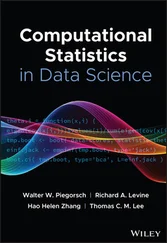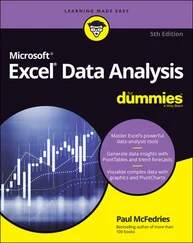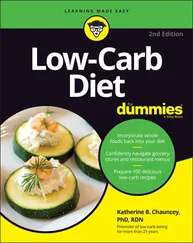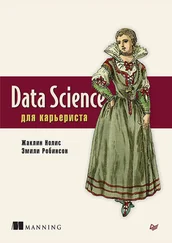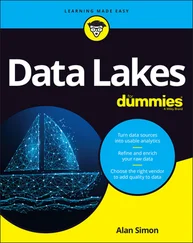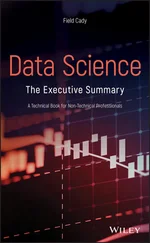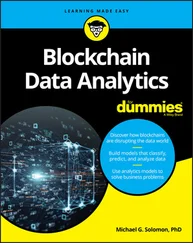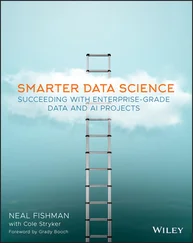
Data Science For Dummies®, 3rd Edition
Published by: John Wiley & Sons, Inc.,111 River Street, Hoboken, NJ 07030-5774, www.wiley.com
Copyright © 2021 by John Wiley & Sons, Inc., Hoboken, New Jersey
Published simultaneously in Canada
No part of this publication may be reproduced, stored in a retrieval system or transmitted in any form or by any means, electronic, mechanical, photocopying, recording, scanning or otherwise, except as permitted under Sections 107 or 108 of the 1976 United States Copyright Act, without the prior written permission of the Publisher. Requests to the Publisher for permission should be addressed to the Permissions Department, John Wiley & Sons, Inc., 111 River Street, Hoboken, NJ 07030, (201) 748-6011, fax (201) 748-6008, or online at http://www.wiley.com/go/permissions .
Trademarks:Wiley, For Dummies, the Dummies Man logo, Dummies.com, Making Everything Easier, and related trade dress are trademarks or registered trademarks of John Wiley & Sons, Inc. and may not be used without written permission. All other trademarks are the property of their respective owners. John Wiley & Sons, Inc. is not associated with any product or vendor mentioned in this book.
LIMIT OF LIABILITY/DISCLAIMER OF WARRANTY: THE PUBLISHER AND THE AUTHOR MAKE NO REPRESENTATIONS OR WARRANTIES WITH RESPECT TO THE ACCURACY OR COMPLETENESS OF THE CONTENTS OF THIS WORK AND SPECIFICALLY DISCLAIM ALL WARRANTIES, INCLUDING WITHOUT LIMITATION WARRANTIES OF FITNESS FOR A PARTICULAR PURPOSE. NO WARRANTY MAY BE CREATED OR EXTENDED BY SALES OR PROMOTIONAL MATERIALS. THE ADVICE AND STRATEGIES CONTAINED HEREIN MAY NOT BE SUITABLE FOR EVERY SITUATION. THIS WORK IS SOLD WITH THE UNDERSTANDING THAT THE PUBLISHER IS NOT ENGAGED IN RENDERING LEGAL, ACCOUNTING, OR OTHER PROFESSIONAL SERVICES. IF PROFESSIONAL ASSISTANCE IS REQUIRED, THE SERVICES OF A COMPETENT PROFESSIONAL PERSON SHOULD BE SOUGHT. NEITHER THE PUBLISHER NOR THE AUTHOR SHALL BE LIABLE FOR DAMAGES ARISING HEREFROM. THE FACT THAT AN ORGANIZATION OR WEBSITE IS REFERRED TO IN THIS WORK AS A CITATION AND/OR A POTENTIAL SOURCE OF FURTHER INFORMATION DOES NOT MEAN THAT THE AUTHOR OR THE PUBLISHER ENDORSES THE INFORMATION THE ORGANIZATION OR WEBSITE MAY PROVIDE OR RECOMMENDATIONS IT MAY MAKE. FURTHER, READERS SHOULD BE AWARE THAT INTERNET WEBSITES LISTED IN THIS WORK MAY HAVE CHANGED OR DISAPPEARED BETWEEN WHEN THIS WORK WAS WRITTEN AND WHEN IT IS READ.
For general information on our other products and services, please contact our Customer Care Department within the U.S. at 877-762-2974, outside the U.S. at 317-572-3993, or fax 317-572-4002. For technical support, please visit https://hub.wiley.com/community/support/dummies .
Wiley publishes in a variety of print and electronic formats and by print-on-demand. Some material included with standard print versions of this book may not be included in e-books or in print-on-demand. If this book refers to media such as a CD or DVD that is not included in the version you purchased, you may download this material at http://booksupport.wiley.com . For more information about Wiley products, visit www.wiley.com .
Library of Congress Control Number: 2021944259
ISBN 978-1-119-81155-8 (pbk); ISBN 978-1-119-81166-4 (ebk); ISBN 978-1-119-81161-9 (ebk)
Data Science For Dummies®
To view this book's Cheat Sheet, simply go to www.dummies.comand search for “Data Science For Dummies Cheat Sheet” in the Search box.
Table of Contents
1 Cover
2 Title Page
3 Copyright
4 Introduction About This Book Foolish Assumptions Icons Used in This Book Beyond the Book Where to Go from Here
5 Part 1: Getting Started with Data Science Chapter 1: Wrapping Your Head Around Data Science Seeing Who Can Make Use of Data Science Inspecting the Pieces of the Data Science Puzzle Exploring Career Alternatives That Involve Data Science Chapter 2: Tapping into Critical Aspects of Data Engineering Defining Big Data and the Three Vs Identifying Important Data Sources Grasping the Differences among Data Approaches Storing and Processing Data for Data Science
6 Part 2: Using Data Science to Extract Meaning from Your Data Chapter 3: Machine Learning Means … Using a Machine to Learn from Data Defining Machine Learning and Its Processes Considering Learning Styles Seeing What You Can Do Chapter 4: Math, Probability, and Statistical Modeling Exploring Probability and Inferential Statistics Quantifying Correlation Reducing Data Dimensionality with Linear Algebra Modeling Decisions with Multiple Criteria Decision-Making Introducing Regression Methods Detecting Outliers Introducing Time Series Analysis Chapter 5: Grouping Your Way into Accurate Predictions Starting with Clustering Basics Identifying Clusters in Your Data Categorizing Data with Decision Tree and Random Forest Algorithms Drawing a Line between Clustering and Classification Making Sense of Data with Nearest Neighbor Analysis Classifying Data with Average Nearest Neighbor Algorithms Classifying with K-Nearest Neighbor Algorithms Solving Real-World Problems with Nearest Neighbor Algorithms Chapter 6: Coding Up Data Insights and Decision Engines Seeing Where Python and R Fit into Your Data Science Strategy Using Python for Data Science Using Open Source R for Data Science Chapter 7: Generating Insights with Software Applications Choosing the Best Tools for Your Data Science Strategy Getting a Handle on SQL and Relational Databases Investing Some Effort into Database Design Narrowing the Focus with SQL Functions Making Life Easier with Excel Chapter 8: Telling Powerful Stories with Data Data Visualizations: The Big Three Designing to Meet the Needs of Your Target Audience Picking the Most Appropriate Design Style Selecting the Appropriate Data Graphic Type Testing Data Graphics Adding Context
7 Part 3: Taking Stock of Your Data Science Capabilities Chapter 9: Developing Your Business Acumen Bridging the Business Gap Traversing the Business Landscape Surveying Use Cases and Case Studies Chapter 10: Improving Operations Establishing Essential Context for Operational Improvements Use Cases Exploring Ways That Data Science Is Used to Improve Operations Chapter 11: Making Marketing Improvements Exploring Popular Use Cases for Data Science in Marketing Turning Web Analytics into Dollars and Sense Building Data Products That Increase Sales-and-Marketing ROI Increasing Profit Margins with Marketing Mix Modeling Chapter 12: Enabling Improved Decision-Making Improving Decision-Making Barking Up the Business Intelligence Tree Using Data Analytics to Support Decision-Making Increasing Profit Margins with Data Science Chapter 13: Decreasing Lending Risk and Fighting Financial Crimes Decreasing Lending Risk with Clustering and Classification Preventing Fraud Via Natural Language Processing (NLP) Chapter 14: Monetizing Data and Data Science Expertise Setting the Tone for Data Monetization Monetizing Data Science Skills as a Service Selling Data Products Direct Monetization of Data Resources Pricing Out Data Privacy
8 Part 4: Assessing Your Data Science Options Chapter 15: Gathering Important Information about Your Company Unifying Your Data Science Team Under a Single Business Vision Framing Data Science around the Company’s Vision, Mission, and Values Taking Stock of Data Technologies Inventorying Your Company’s Data Resources People-Mapping Avoiding Classic Data Science Project Pitfalls Tuning In to Your Company’s Data Ethos Making Information-Gathering Efficient Chapter 16: Narrowing In on the Optimal Data Science Use Case Reviewing the Documentation Selecting Your Quick-Win Data Science Use Cases Picking between Plug-and-Play Assessments Chapter 17: Planning for Future Data Science Project Success Preparing an Implementation Plan Supporting Your Data Science Project Plan Executing On Your Data Science Project Plan Chapter 18: Blazing a Path to Data Science Career Success Navigating the Data Science Career Matrix Landing Your Data Scientist Dream Job Leading with Data Science Starting Up in Data Science
Читать дальше


![Роман Зыков - Роман с Data Science. Как монетизировать большие данные [litres]](/books/438007/roman-zykov-roman-s-data-science-kak-monetizirova-thumb.webp)

